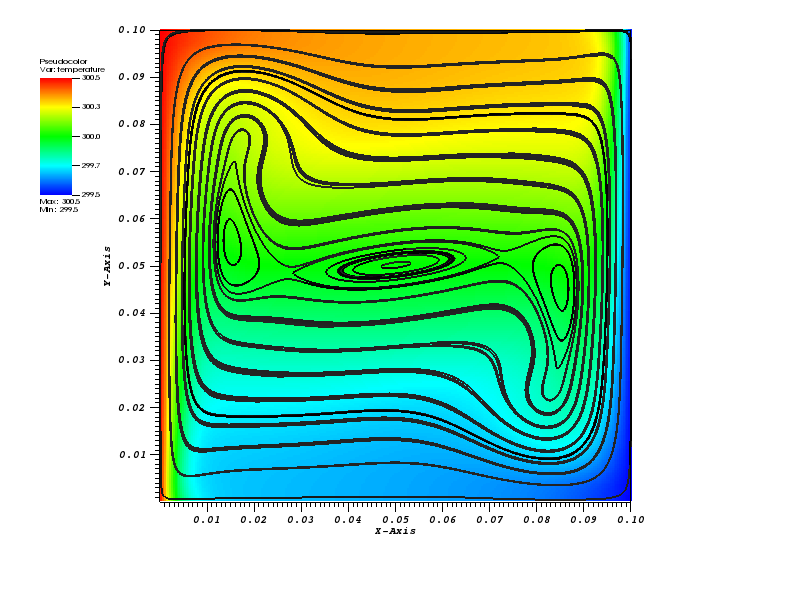Natural convection in a square cavity at \( Ra=10^6 \) and \( Pr=0.71 \).
Natural convection in a square cavity at \( Ra=10^6 \) and \( Pr=0.71 \).
This test case simulates the natural convection problem in a square cavity at \( Ra=10^6 \) (convection is dominant Rayleigh number) and \( Pr=0.71 \) (Prandtl number). The aims of this test case are to:
Domain is square, its opposite corner coordinates being \((0,0,0)\) and \((0.1,0.1,0.1)\). We solve the Navier-Stokes and the Energy equations on the whole domain.
The following configuration is used:
Velocity boundary conditions:
| Boundary | Condition |
|---|---|
| left | Wall |
| right | Wall |
| bottom | Wall |
| top | Wall |
| back | Symmetry |
| front | Symmetry |
Temperature boundary conditions:
| Boundary | Condition | Value |
|---|---|---|
| left | Dirichlet | \( T = T_{min} = 299.5 K \) |
| right | Dirichlet | \( T = T_{max} = 300.5 K \) |
| bottom | Neumann | \( \partial_{\mathrm n}T = 0 \) |
| top | Neumann | \( \partial_{\mathrm n}T = 0 \) |
| back | Neumann | \( \partial_{\mathrm n}T = 0 \) |
| front | Neumann | \( \partial_{\mathrm n}T = 0 \) |
Density is computed thanks to a linear law:
\( \rho \ = \ \rho_0 \ (1 - \beta_T \ (T - T_0) ) \)
The gravity term of the Navier-Stokes equations is activated and the Boussinesq approximation chosen.
Second order spatial convergence is expected on the wall Nusselt number and mean velocity intensity.
To check the symmetry of the code, a rotation of the configuration is tested and produce same results up to computer precision. This done in the validation script of the code. Spatial convergence is done on the above configuration.
The grid size starts from 32 in every direction to 512.
Temperature field and streamlines of the velocity feld, obtained with a 256x256 grid, are presented figure 1.

Second order convergence is observed on left and right Nusselt numbers, as well as on mean velocity magnitude (see Table below). We observe small differences between left and right Nusselt number due to second order boundary condition implementation and second order wall temperature gradient computation. Nevertheless this difference converges with the refinement of the mesh. A reference solution, given in [1], is Nu=8.8252.
| Mesh | Left Nusselt | Order | Right Nusselt | Order | Velocity | Order |
|---|---|---|---|---|---|---|
| 32 | 1.049056e+01 | n/a | 1.049131e+01 | n/a | 3.792175e-03 | n/a |
| 64 | 9.184279e+00 | n/a | 9.184525e+00 | n/a | 3.681106e-03 | n/a |
| 128 | 8.901375e+00 | +2.207075 | 8.901414e+00 | +2.206584 | 3.638767e-03 | +1.391398 |
| 256 | 8.842457e+00 | +2.263531 | 8.842462e+00 | +2.263758 | 3.627719e-03 | +1.938184 |
| 512 | 8.829294e+00 | +2.162209 | 8.829294e+00 | +2.162534 | 3.624949e-03 | +1.995758 |
[1] P. Le Quéré, Accurate solutions to the square differentially heated cavity at high Rayleigh number. Comput. Fluids, 20, (1991), 19–41.